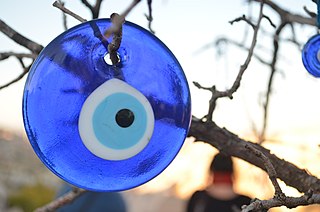
The areca nut or betel nut is the fruit of the areca palm, which grows in much of the tropical Pacific, South Asia, Southeast Asia, and parts of east Africa. It is not to be confused with betel leaves that are often used to wrap it.

Gutka, ghutka, guṭkha or betel quid is a chewing tobacco preparation made of crushed areca nut, tobacco, catechu, paraffin wax, slaked lime and sweet or savory flavourings, in India, Pakistan, other Asian countries, and North America.

Saliva is an extracellular fluid produced and secreted by salivary glands in the mouth. In humans, saliva is around 99% water, plus electrolytes, mucus, white blood cells, epithelial cells, enzymes, and antimicrobial agents.

The evil eye is a supernatural belief in a curse brought about by a malevolent glare, usually inspired by envy. The belief in the evil eye among humans has existed since prehistory, and amulets to protect against it have been found dating to about 5,000 years ago. It is estimated that around 40% of the world's population believes in the evil eye.

Phlegm is mucus produced by the respiratory system, excluding that produced by the throat nasal passages. It often refers to respiratory mucus expelled by coughing, otherwise known as sputum. Phlegm, and mucus as a whole, is in essence a water-based gel consisting of glycoproteins, immunoglobulins, lipids and other substances. Its composition varies depending on climate, genetics, and state of the immune system. Its color can vary from transparent to pale or dark yellow and green, from light to dark brown, and even to dark grey depending on the constituents. The body naturally produces about 1 quart of phlegm every day to capture and clear substances in the air and bacteria from the nose and throat.

The betel, Piper betle, is a species of flowering plant in the pepper family Piperaceae, native to Southeast Asia. It is an evergreen, dioecious vine, with glossy heart-shaped leaves and white catkins. Betel plants are cultivated for their leaves which are most commonly used as flavoring in chewing areca nut.

Betel nut chewing, also called betel quid chewing or areca nut chewing, is a practice in which areca nuts are chewed together with slaked lime and betel leaves for their stimulant and narcotic effects, the primary psychoactive compound being arecoline. The practice is widespread in Southeast Asia, Micronesia, Island Melanesia, and South Asia. It is also found among both Han Chinese immigrants and indigenous peoples of Taiwan, Madagascar, and parts of southern China. It was introduced to the Caribbean in colonial times.

A spittoon is a receptacle made for spitting into, especially by users of chewing and dipping tobacco. It is also known as a cuspidor, although that term is also used for a type of spitting sink used in dentistry.

Chewing tobacco is a type of smokeless tobacco product that is placed between the cheek and lower gum to draw out its flavor. It consists of coarsely chopped aged tobacco that is flavored and often sweetened; it is not ground fine like dipping tobacco. Unwanted juices are then spat.

Knocking on wood is an apotropaic tradition of literally touching, tapping, or knocking on wood, or merely stating that one is doing or intending to do so, in order to avoid "tempting fate" after making a favorable prediction or boast, or a declaration concerning one's own death or another unfavorable situation.

Areca catechu is a species of palm which grows in much of the tropical Pacific, Asia, and parts of east Africa. The palm is native to the Philippines, but is widespread in cultivation and is considered naturalized in Malaysia, Indonesia, New Guinea, Taiwan, Madagascar, Cambodia, Laos, Myanmar, Thailand, Vietnam, southern China, India, Nepal, Bangladesh, the Maldives, Sri Lanka, parts of the Pacific Islands, and also in the West Indies.

Dipping tobacco is a type of finely ground or shredded, moistened smokeless tobacco product. It is commonly and idiomatically known as dip. Dipping tobacco is used by placing a pinch, or "dip", of tobacco between the lip and the gum. The act of using it is called dipping. Dipping tobacco is colloquially called chaw, snuff, rub, or fresh leaf among other terms; because of this, it is sometimes confused with other tobacco products—namely dry snuff.

An eye bead or naẓar is an eye-shaped amulet believed by many to protect against the evil eye. The term is also used in Azerbaijani, Bengali, Hebrew, Hindi–Urdu, Kurdish, Pashto, Persian, Punjabi, Turkish and other languages. In Turkey, it is known by the name nazar boncuğu, in Greece is known as máti. In Persian and Afghan folklore, it is called a cheshm nazar or nazar qurbāni (نظرقربانی). In India and Pakistan, the Hindi-Urdu slogan chashm-e-baddoor is used to ward off the evil eye. In the Indian subcontinent, the phrase nazar lag gai is used to indicate that one has been affected by the evil eye.

The hamsa, also known as the hand ofFatima, is a palm-shaped amulet popular throughout North Africa and in the Middle East and commonly used in jewellery and wall hangings. Depicting the open hand, an image recognized and used as a sign of protection in many times throughout history, the hamsa has been traditionally believed to provide defense against the evil eye.
Bohni is a social and commercial custom of India and Pakistan that is based on the belief that the first sale of a day establishes the seller's luck for subsequent choti transactions during the remainder of the day. In practical terms this means that sellers try to ensure that the first sale happens on a cash-only basis, and ideally without any discounts, though the social protocol associated with bohni sales varies by region. Unless the price is egregious, it is considered good manners for customers to be generous if they are engaged in a bohni transaction with the seller. If the buyer is trusted, the seller will sometimes allow the buyer to state a price that is binding on both, with the expectation that the buyer will demonstrate generosity.

There are approximately 57 million smokers in Indonesia, among a population of 273 million people. Around 63% of men and 5% of women report smoking, equating to 34% of the population. The majority, 88% of Indonesian smokers, use clove-flavoured kreteks. Kretek manufacturers directly employ over 180,000 people in Indonesia and an additional 10 million indirectly. Indonesia is the fifth largest tobacco market in the world, and in 2008 over 165 billion cigarettes were sold in the country.

A Nazar battu is an icon, charm bracelet, tattoo or other object or pattern used in North India and Pakistan to ward-off the evil eye. In Persian and Afghan folklore, it is called a cheshm nazar or nazar qurbāni. In India and Pakistan, the Hindi-Urdu slogan of Persian origin Chashm-e-Baddoor is used to ward off the evil eye.

Betel quid chewing has always been an important part of Thai culture and tradition. In the past, betel chewing was a popular daily activity among Thais all over the country. Betel comes from the plant known as Areca catechu, which grows wild all over Thailand and is known as หมาก (maak).

Betel chewing in China has a long history, particularly in the southern provinces. In modern times, betel nut chewing is popular nationwide. The social debate over betel nut chewing has led the authorities to introduce some restriction policies, though almost all cities in the country still allow the production, sale and consumption of betel nut.



















